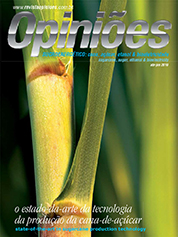Kléber Pereira Lanças
Professor of the Machine and Tire Testing Center of Unesp
Op-AA-24
Harvesting: soil compression
Brazil’s extensive agricultural areas, with different soil, topography and climate characteristics and significant growth in the mechanization of its agriculture, particularly of mechanical harvesting, which is intensively performed in some situations, but often inadequately in others, and while ignoring soil load support capacity and ideal water content for machine traffic.
Such conditions have, to a large extent, been responsible for the deterioration and pauperization of some Brazilian agricultural soils. Indiscriminate agricultural traffic contributes to the appearance of compressed layers of agricultural soil. Thus, when soil is dryer, its capacity to support loads is higher and the probability of compression lower.
Therefore, mechanized soils with inadequate water content (plasticity region) may have their structure considerably compromised. The applied principle in moving vehicles is based on transforming engine rotation and tork into a translational movement, through the transmission gears and wheel contact with the ground.
A vehicle’s main functions are: to assure stable equilibrium and a height from the ground compatible with agricultural working conditions, allowing self-propulsion and steering and the development of machines’ tractive effort. Considering these parameters, two basic types of vehicles were developed: vehicles with tires and caterpillar vehicles, whereas agricultural tractors with tired wheels to this day are the most used in the world.
On sugarcane harvesting machines, the metallic caterpillars have allowed for better operational performance, higher efficiency and more importantly, better stability, and they are easy to operate; however, these machines are usually more expensive than those with tired wheels. The vehicle contact area with the ground is a decisive factor for studying vehicle/ground interaction, apart from allowing significant savings in terms of less compression and better soil preservation.
Tired wheel vehicles have also undergone considerable innovation, with the incorporation of new and advanced manufacturing technologies, in addition to the use in assemblies of double and even triple wheel sets, which significantly increase tractive capacity, making contact areas proportionately larger.
Recently the development of agricultural low pressure, high floating capacity tires (broad with large diameters), known as “LPHF” tires, have made it possible for wheeled tractors to compete with caterpillar tractors on equal terms, at relatively lower acquisition, operation and maintenance costs.
Several studies have shown that radial tires have a better performance (allowing for larger worked on areas per time unit, with less power required) and less fuel consumption, mainly due to the rigidi-ty effect of the tread that reduces claw deflection and, on the other hand, provides more deformation of the tire sidewall, increasing the contact area with the ground.
The increased contact area with the ground reduces tire skidding and pressure applied to the ground, resulting in lower compression rates brought about by tractor and agricultural machine traffic. Just recently, engineers of tire and tractor manufacturers, together with researchers in universities, discovered that radial tires can work much better when calibrated to “the lowest possible pressure, set as a function of a wheel’s distributed weight”.
Depending on the type of ground on which a tractor will operate, after a tire type and model is selected, its ballasting is very important. On non-cohesive soils, made up of a granular powderish mass, such as sand, the applied tractive force will depend mainly on the tractor’s weight, and the location of its gravity center, its ballasting, and its weight transference are extremely important.
Whenever a high tractive force is demanded of the tractor it is recommended that it operate with maximum ballasting, and because of the load distribution to each wheel one should select a tire that requires less inflation pressure, that allows for a larger contact area (more traction on clayey soils) and less soil compression. Tire load and pressure should always be set according to the specification tables of the tire and tractor manufacturers.




